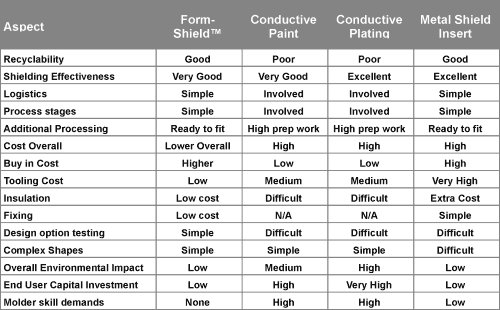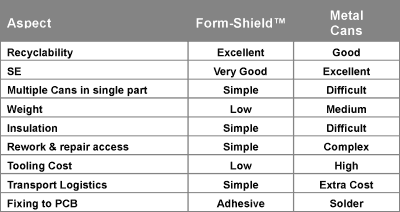
Formed EMI Shields - the green replacement for conductive paint and plating for plastic housingsBy Chris Hills, Managing Director, RH Technical Industries, Reed Niederkorn, VP Engineering & Development, APM, Inc. and Bob Redwood, Regional Sales & marketing Manager, APM |
APM and RHTI are both members of the Laird Group PLC. APM is based in Missouri, USA where development and manufacturing is established. It also has manufacturing sites in Germany, UK and Taiwan as well as sales offices in Japan and Singapore. They are the manufacturers of a wide range of EMI protection products and have grown very rapidly over the last 5 years. APM has recently received an award for "Customer Service Innovation" from an independent market analysis firm.
RHTI is an industrial graphics printer based in the UK and has gained very wide experience over the last 20 years of printing conductive materials with precision and in the last two years undertaking extensive work in the field of In Mould Decoration for the telecomms market. RHTI is qualified to ISO 9001 and has recently been awarded the Environmental Management Standard ISO 14001.
The joint efforts of these two companies has brought together the needs of the customer, a thorough understanding of the needs of EMI solutions, and expertise in print and forming to develop a new and exciting solution to the market.
| R&TTE Forum Proceedings |
|---|
|
An R&TTE Forum at Newbury, chaired by Vic Clements, Radio Frequency Investigation Ltd, included presentations by Martin Fenton, Radiocommunications Agency; Dr Michael Sharpe, ETSI; Ken White, BSI; Simon Barrowcliff, TRL EMC Ltd; Ben Wrigley, KTL Ltd and Paul Lewis, BABT Product Service Ltd.
130 Pages of infomation on R&TTE. Cost £35. |

Figure 1: Form-ShieldTM; The possibilities are only limited by your imagination

Figure 2: Form-ShieldTM; Simple to remove and discard at end-of-life
Plating the enclosure is generally more complex than painting, but a highly conductive surface and a very thin coating may be achieved. In order for the surface of the plastic to accept the plating, it must first be subjected to at least one pretreatment to make the surface catalytic to the electroless deposition. Then the catalytic surface is contacted with an electroless plating bath and the conductor (generally copper or nickel) is deposited on the surface. The complexity of plating operations requires a skilled workforce and significant investment in capital and space, and as with conductive paints, the resulting metal layer is very difficult or impossible to remove when the product reaches the end of its life. Plating is generally more expensive than painting, but the EMI shielding performance is typically superior to painting. Disposal of waste in the recycling process should be a key consideration. Both the painting and plating processes require that the entire enclosure be disposed of while with Form-ShieldTM, only the shielding laminate itself needs to be removed and discarded.
In addition, there has been continual R&D for many years on modifying the plastic by filling it with metal particles or fibers as well as use of conductive plastics including polypyrrole or polyaniline. However, none of these are used to a significant extent today.
APM have been working to develop a new product that removes the limitations of the existing products. The objective is to shield the plastic enclosure at the time of product assembly by inserting a single shielding component rather than creating the shielding as part of the molding or secondary operations. This would allow the plastic enclosure shields to be made in very large volumes at strategic local manufacturing plants and shipped to the assembly point - in just the same way as other components are handled.

Figure 3: A roll-form screen press at RHTI, Andover, UK
The film used as the base for Form-ShieldTM may be any formable film, including Polycarbonate, Polyester and Hybrids, and the thickness of the film can be as low as 0.075mm. UL rated fire retardant films can also be used. The choice of film composition and thickness is determined by the size, shape and extent of draw in the forming step - enough film gauge must exist after forming to be structurally adequate. The maximum percentage elongation that is feasible is limited by the conductive ink and not the thermoformable film, and is generally 35-50%, although deeper draws are possible by application of additional printed layers in selective areas.
The ink is generally silver-based, but silver plated copper, tin/copper and nickel/copper inks are under development. The ink thickness is determined by the shielding effectiveness required of the finished part, and Figure 4 demonstrates the range of ink thickness and the resulting shielding effectiveness.

Figure 4
The inherent flexibility of the screen printing process allows the designer a wide range of options that can be achieved by printing before forming. These options include the development of any conductive pattern from a total flood to hole or grid as shown in Figure 5. It is easy to print on both sides of the material in close register to deal with specific or difficult shielding needs. Where there is a need for insulation of the conductive film this can be achieved by selective printing of a suitable dielectric and finally it is possible to print selective adhesive to provide fixing of the part during assembly. All these options are available to the end user at marginal cost increase as they are all achieved during the high speed web printing phase of manufacture. They are designed to minimise the level of additional work or components required during assembly and therefore to achieve the lowest additional cost.

Figure 5: Form-ShieldTM; An innovative solution to difficult shielding needs

Figure 6

Figure 7
Table 1 summarizes Form-ShieldTM with other products used to provide shielding of cases.

Table 1: Conductive Paint, Conductive Plating & Metal Shield
Form-ShieldTM cans will offer a further advantage to the user and the environment. Metal cans need to be supplied in bandoleers which involves the manufacturer of the cans in the cost of loading these as well as their purchase. The populator then needs to dispose of this material as waste. Form-ShieldTM can be produced in a continuous web with each can being held by break-out legs and the waste material utilised as the logistics carrier thus saving waste and time.
Table 2 shows a comparison between Form-ShieldTM and metal cans to provide on board shielding.

Table 2: Metal Cans
Developments of new printable substrates will allow for the application of conductive gaskets and conductive adhesives prior to forming and will therefore reduce the end cost of the parts once these techniques and materials are ready for market.

Figure 8: Form-ShieldTM; Freedom of Design
Form-ShieldTM has been designed in direct response to customer demand for cost effective, high performance, and environmentally friendly EMI shielding. With manufacturing facilities in North America, Europe and Asia, APM is uniquely positioned to deliver EMI solutions in each major area of consumption and support customer requirements with fully trained local staff.
 © Nutwood UK Ltd 2001 |
Eddystone Court - De Lank Lane St Breward - BODMIN - PL30 4NQ Tel: +44 (0)1208 851530 - Fax: +44 (0)1208 850871 nutwooduk@nutwood.eu.com |
|
|
|